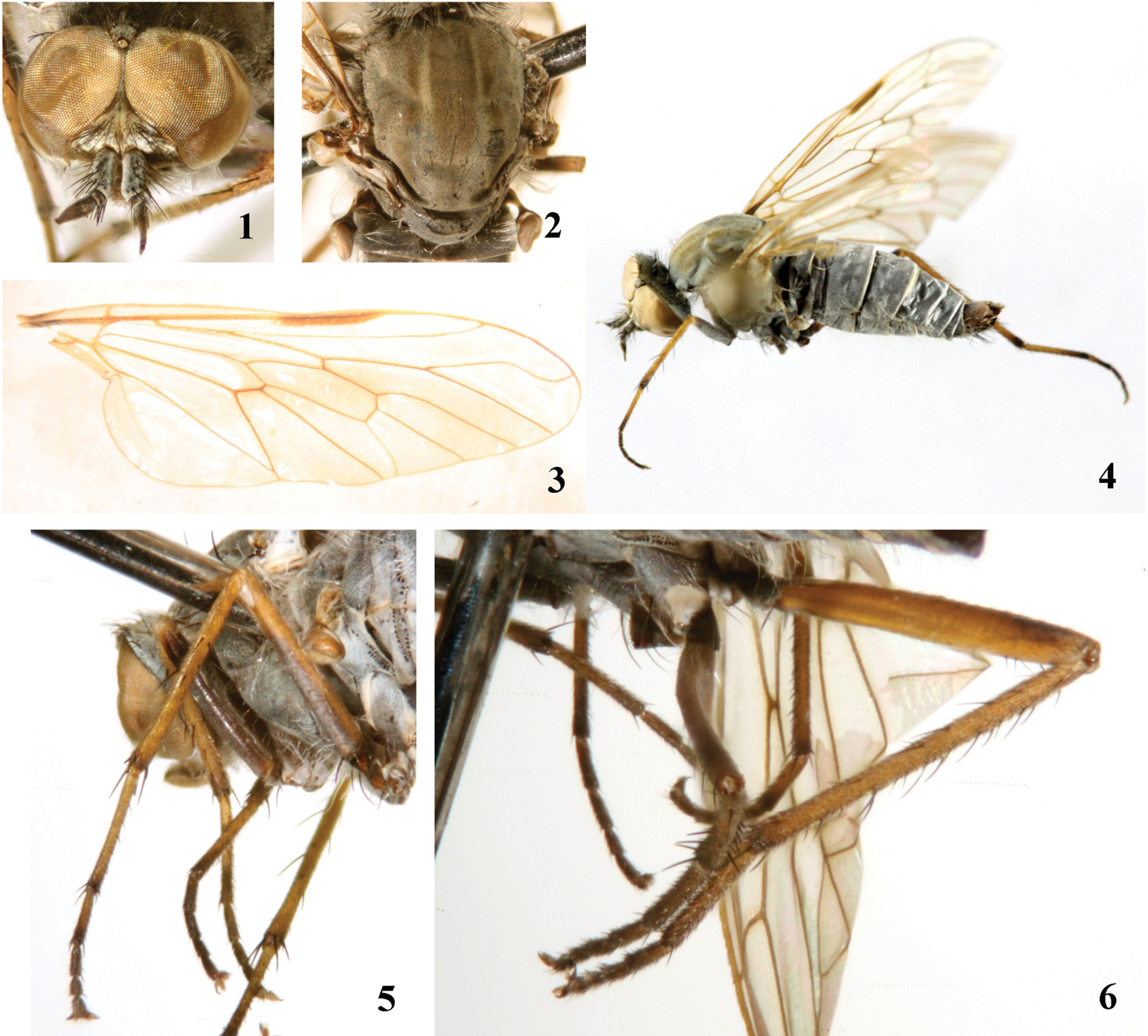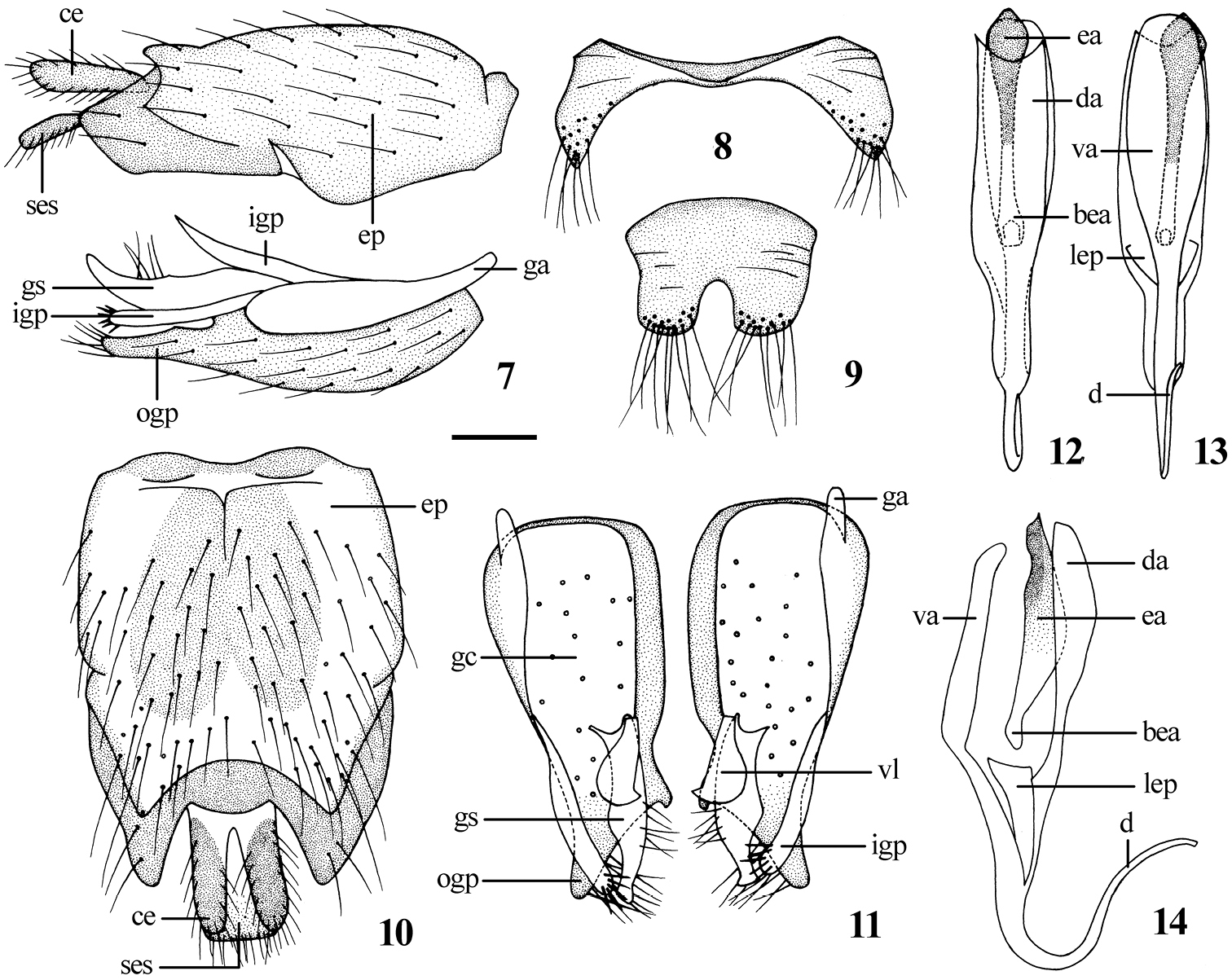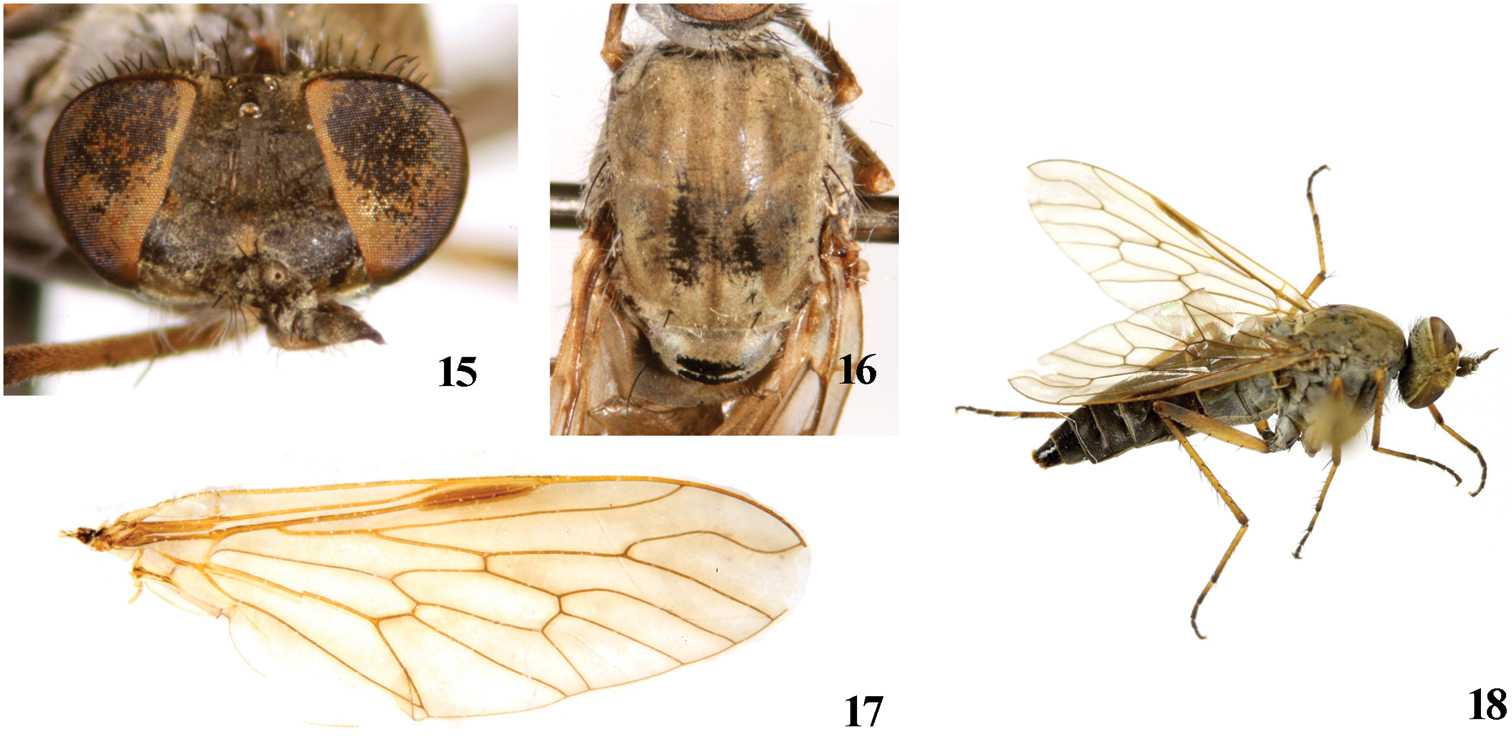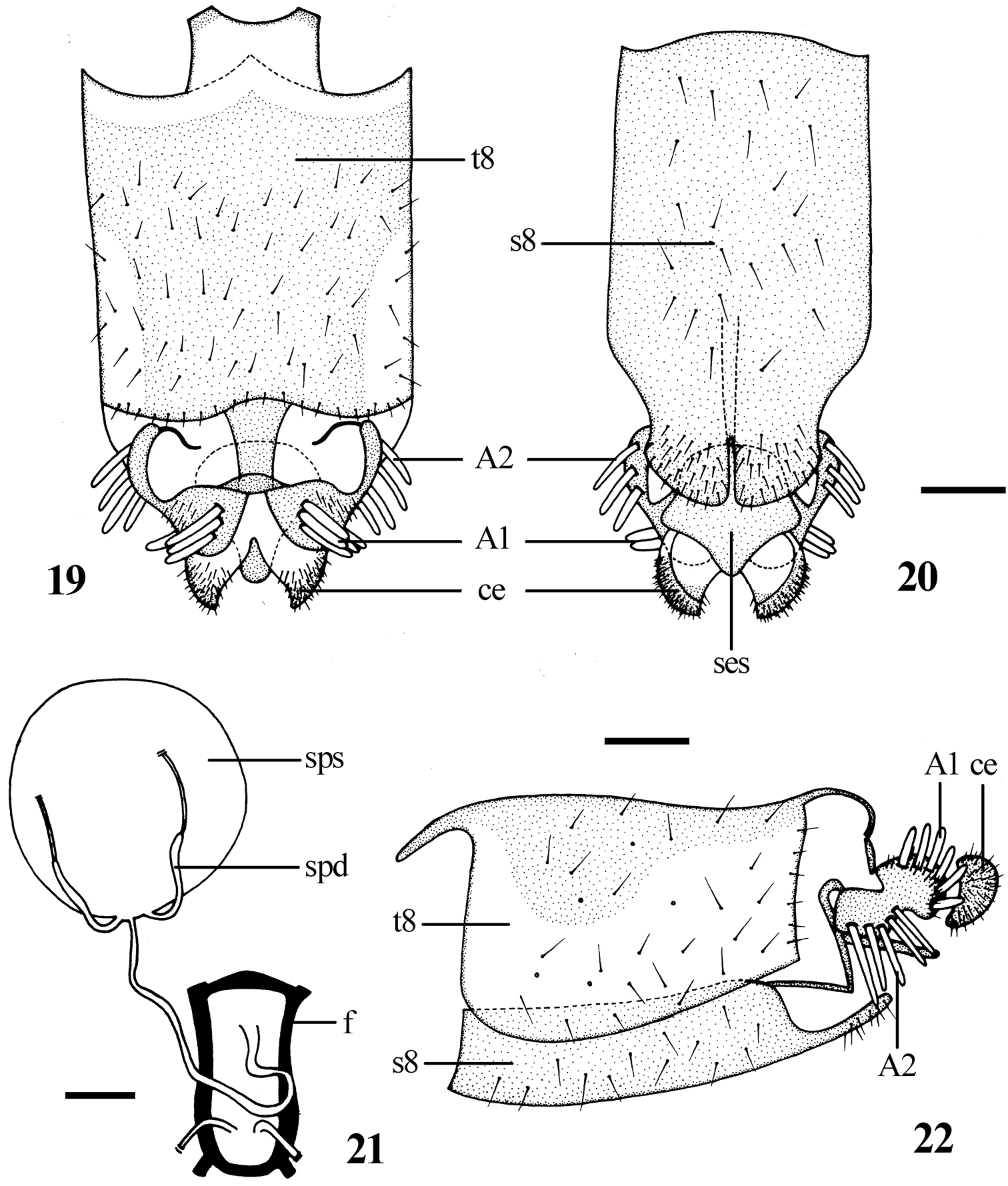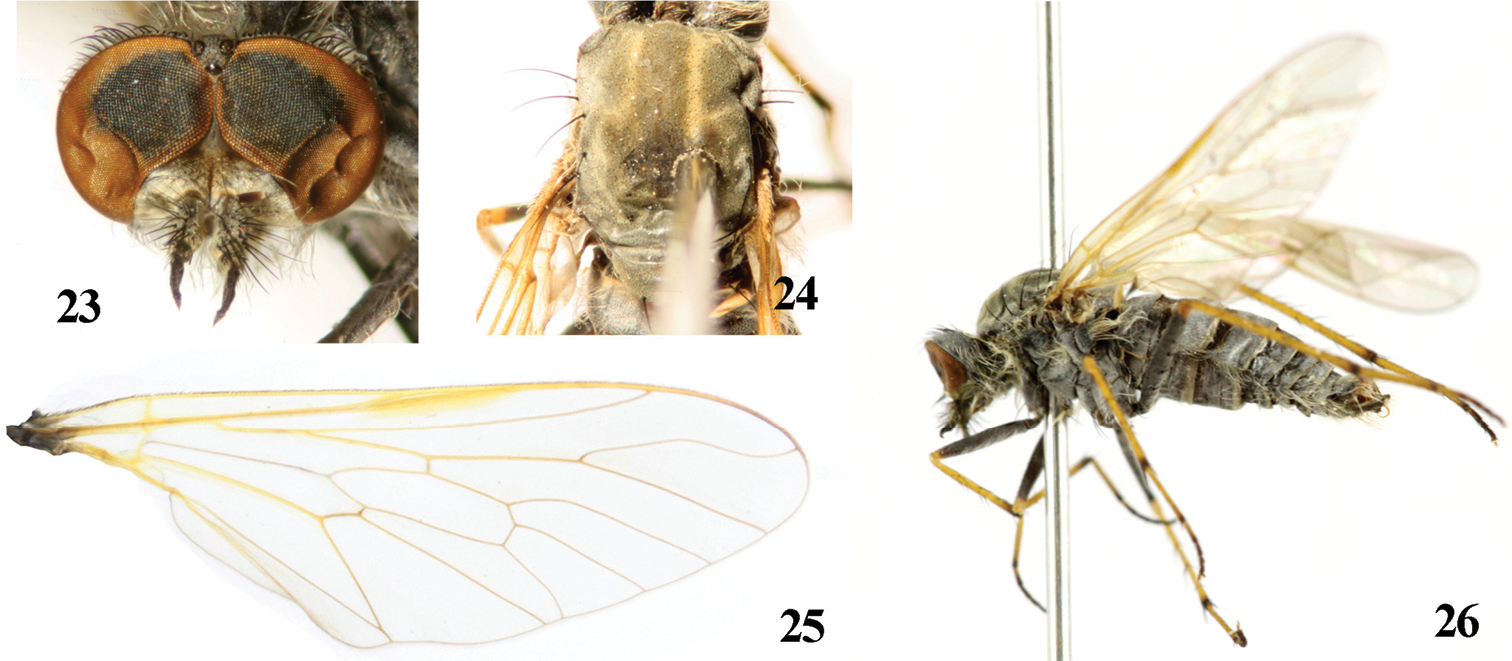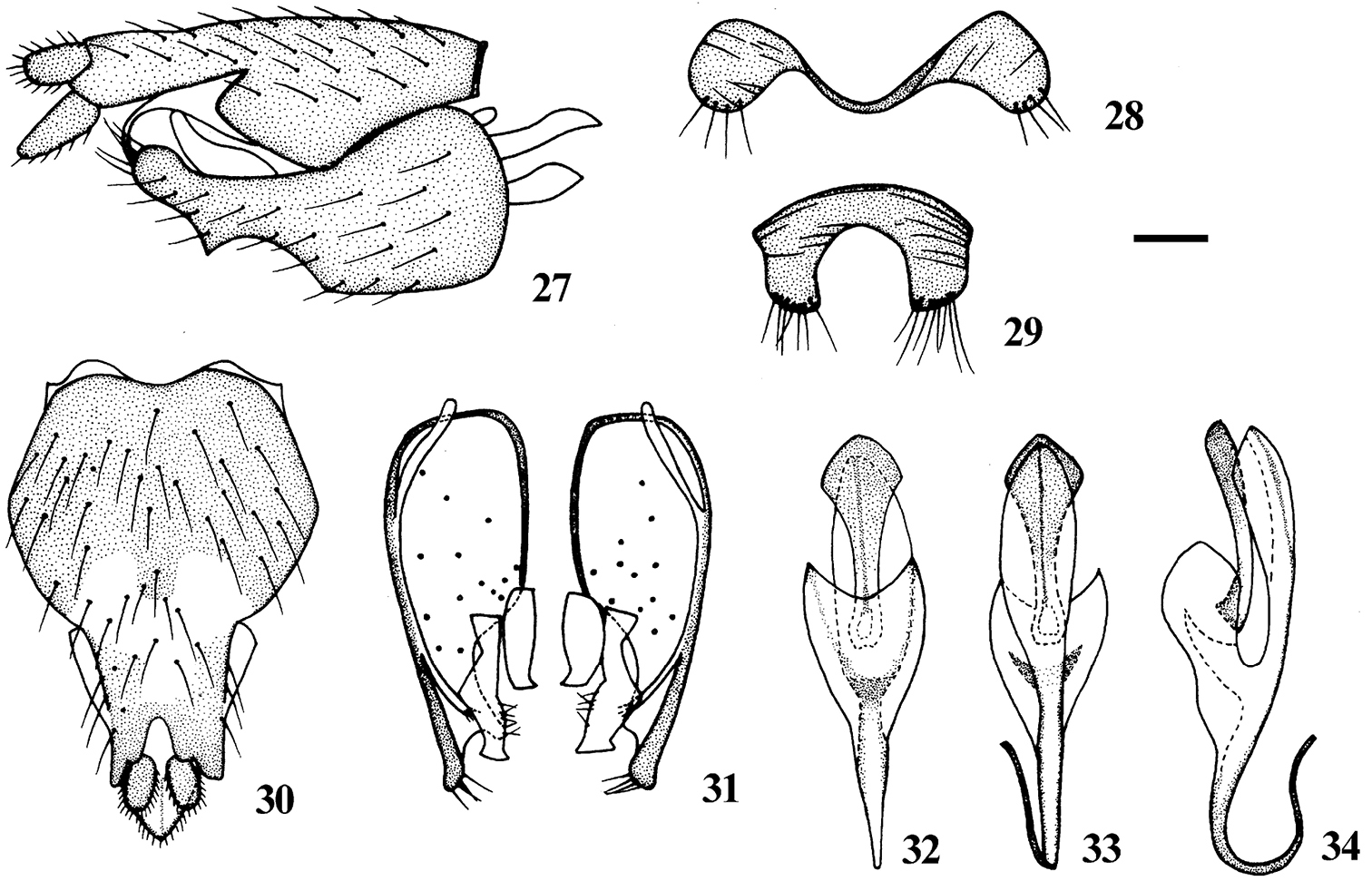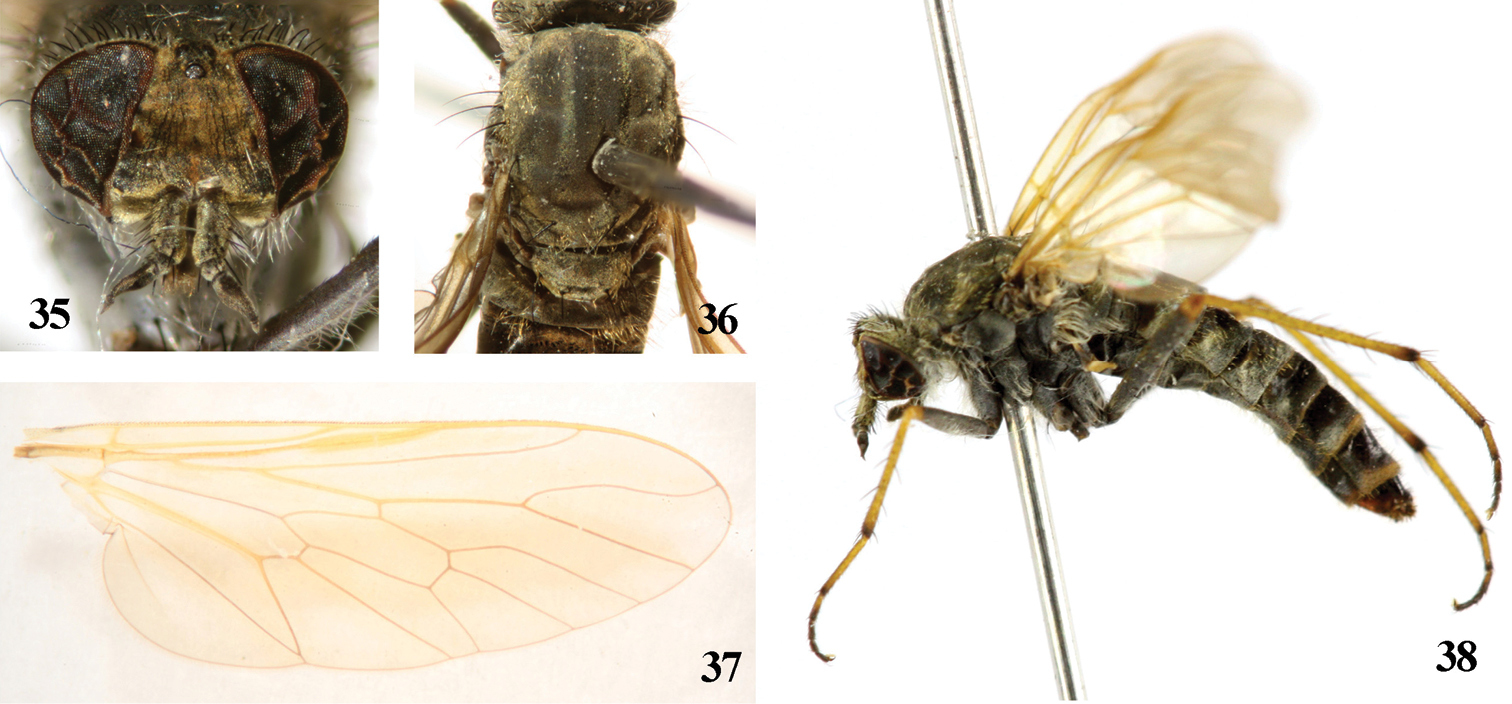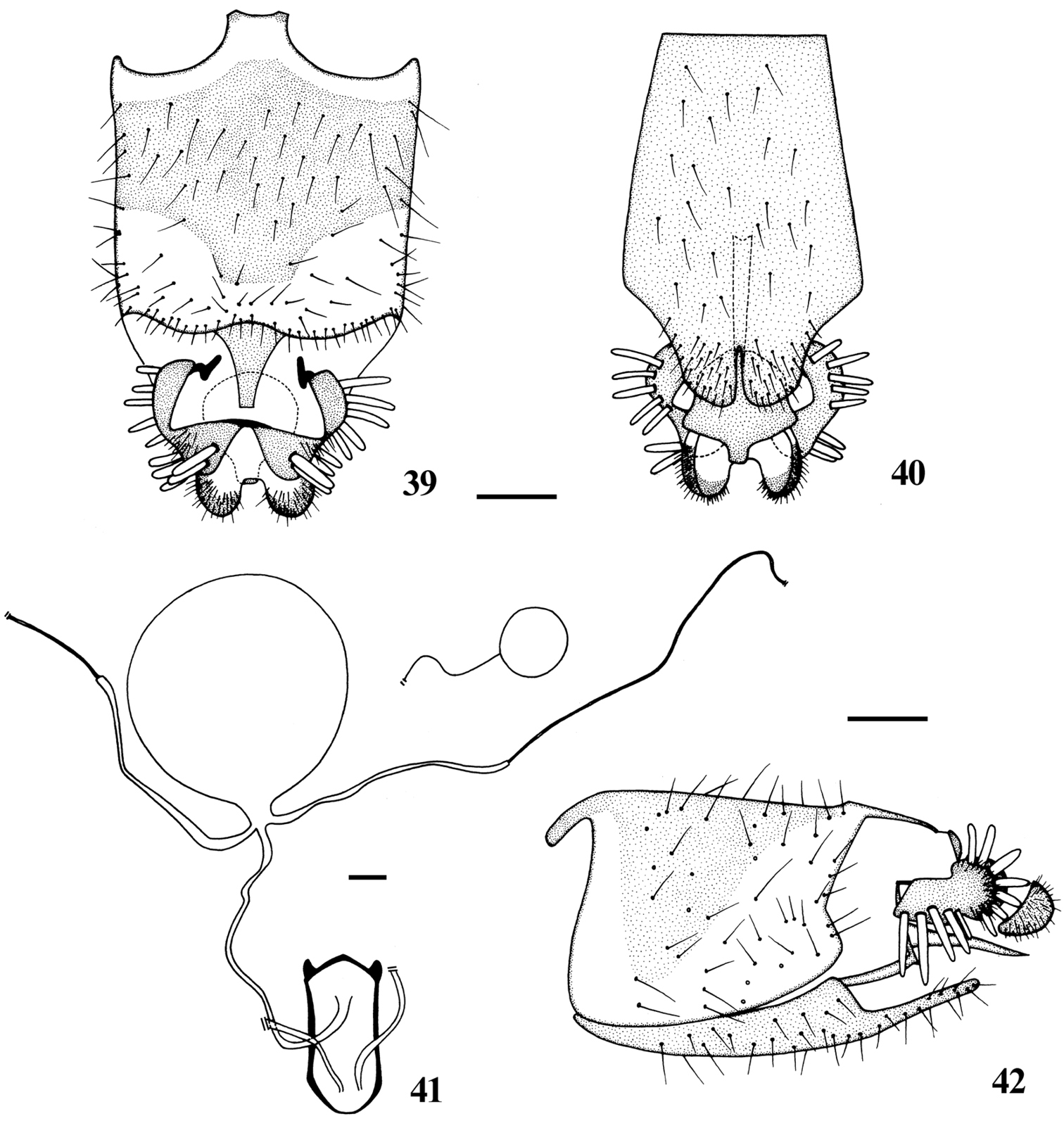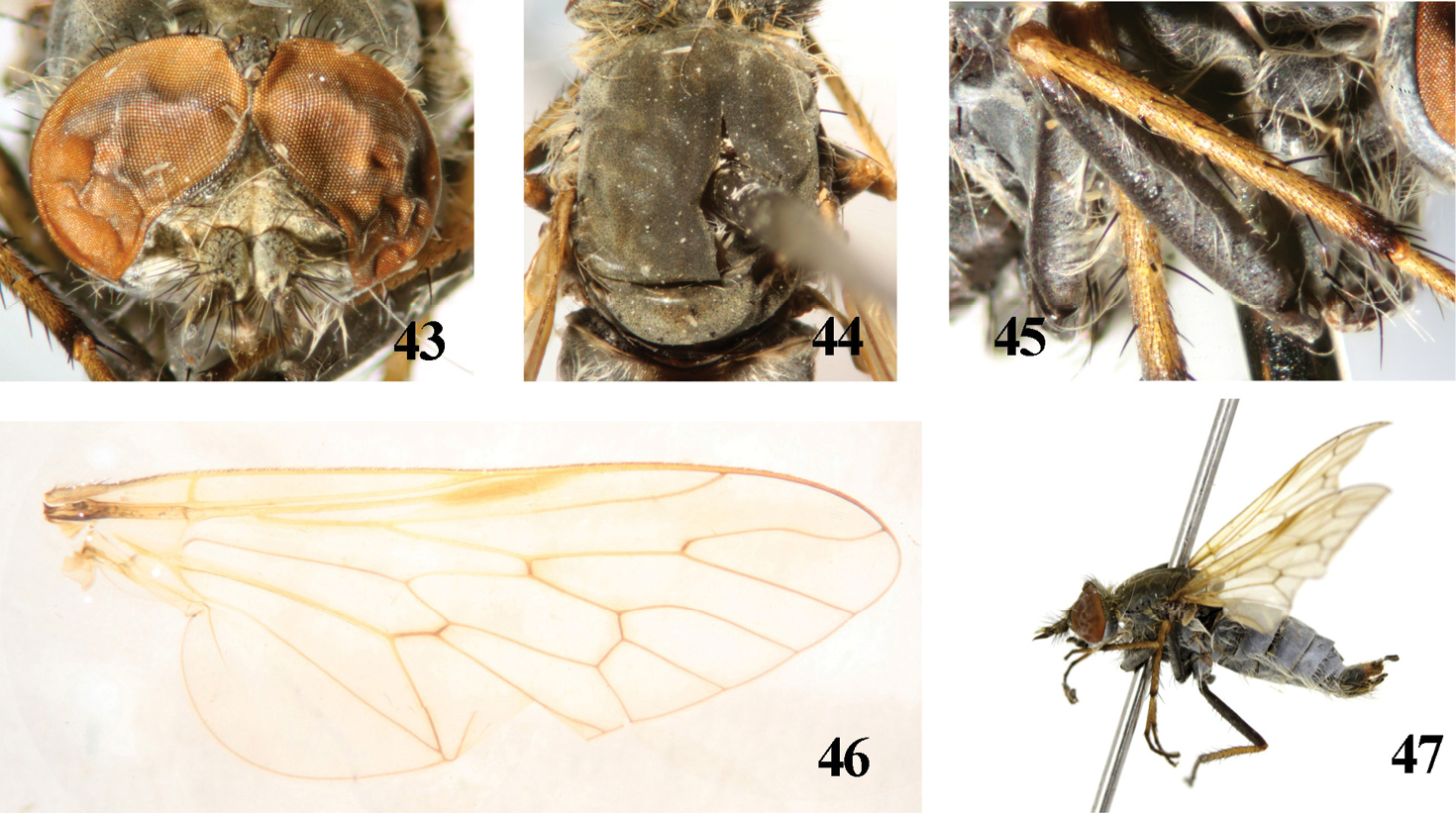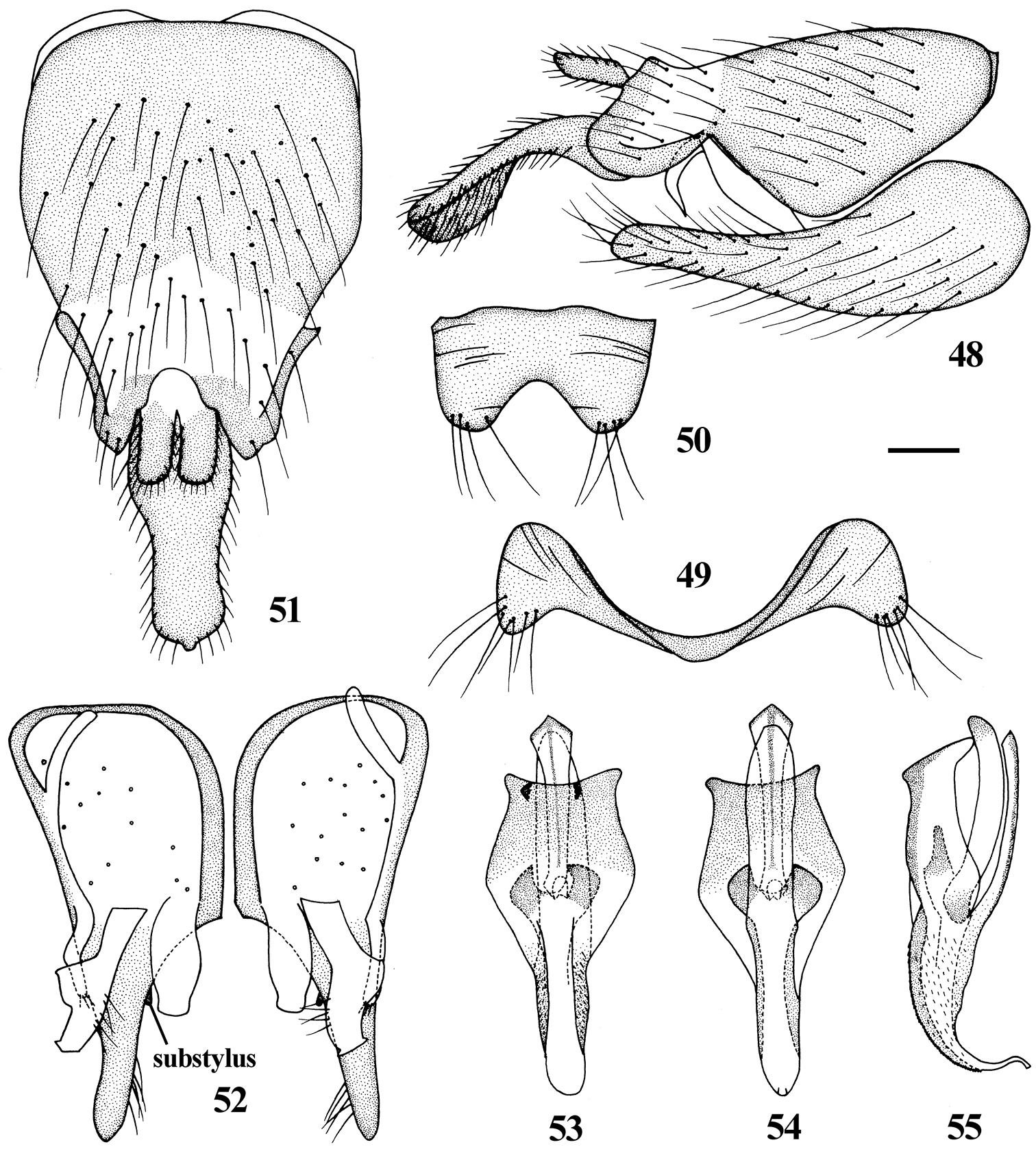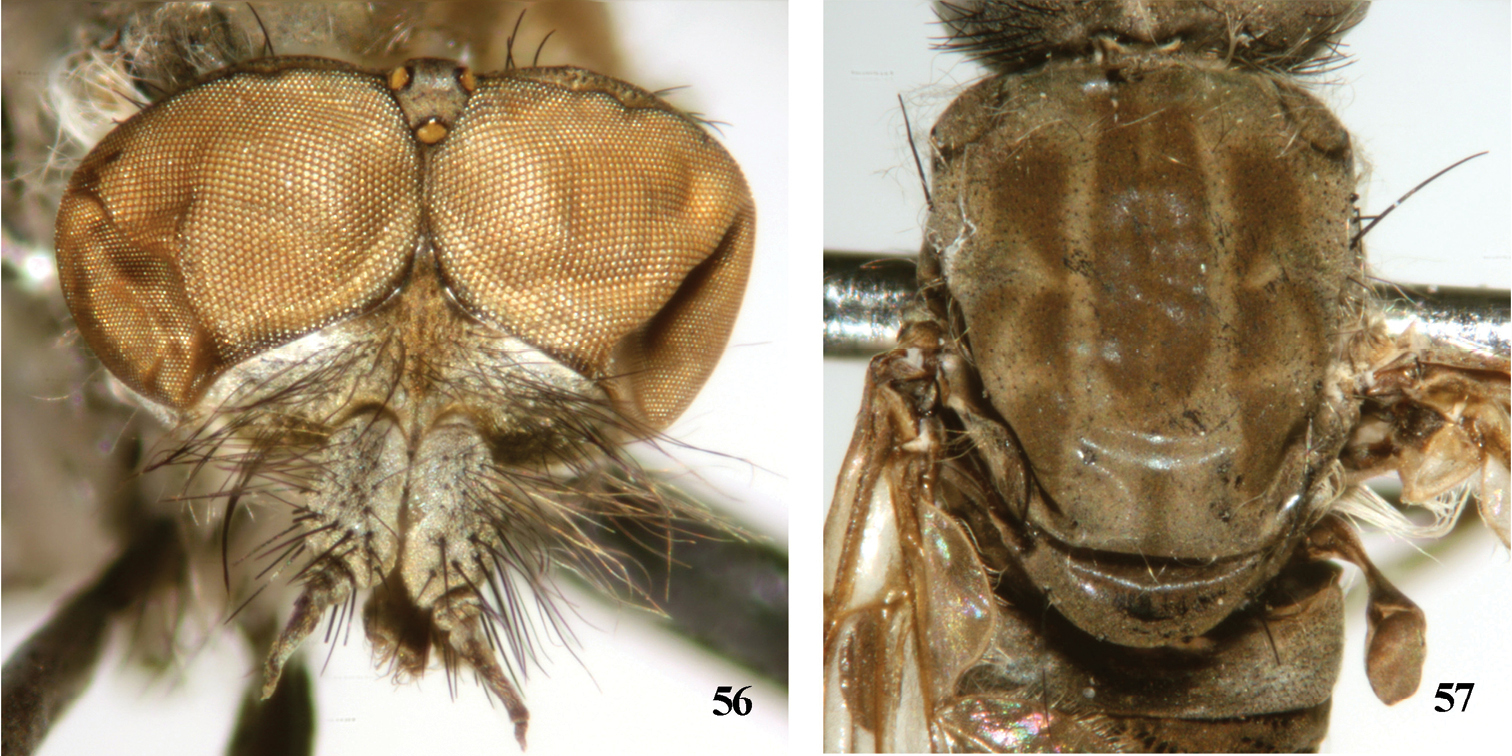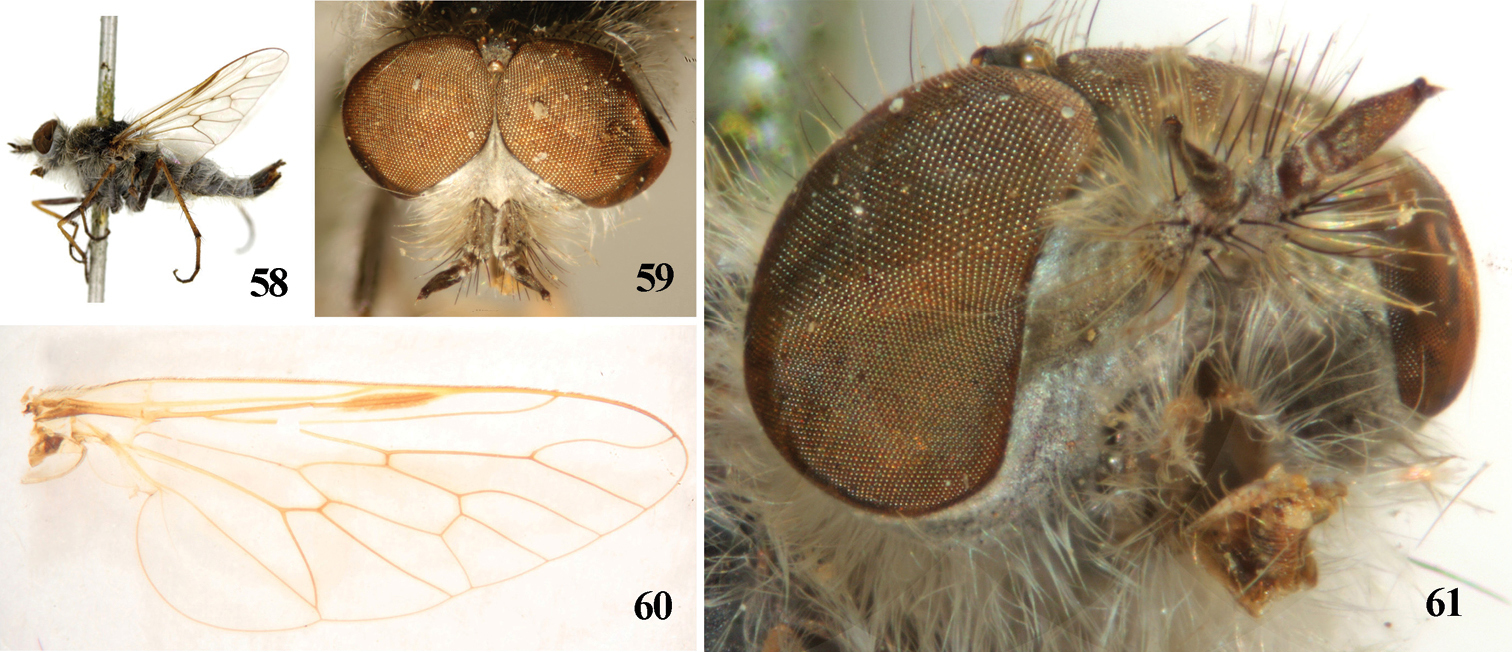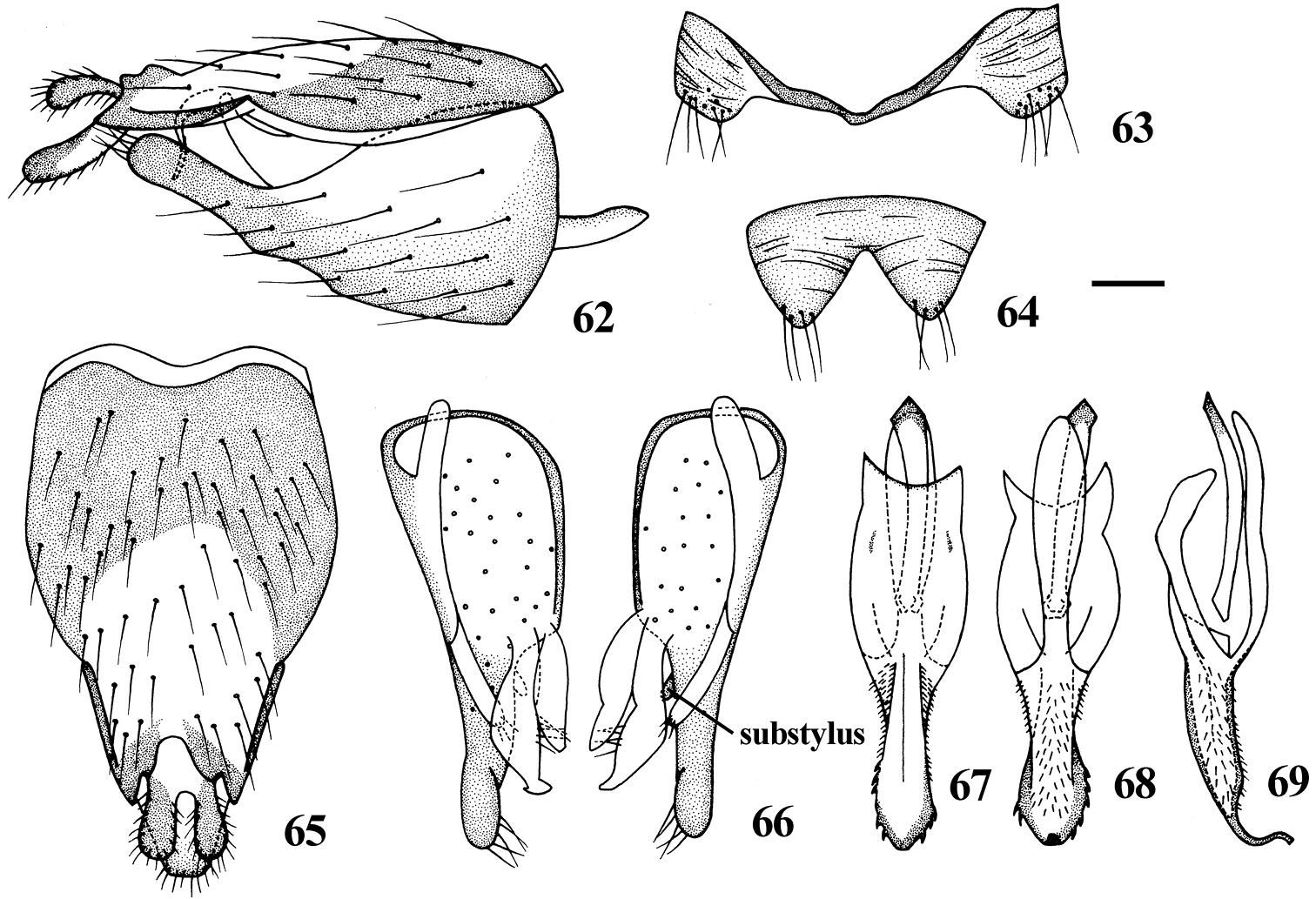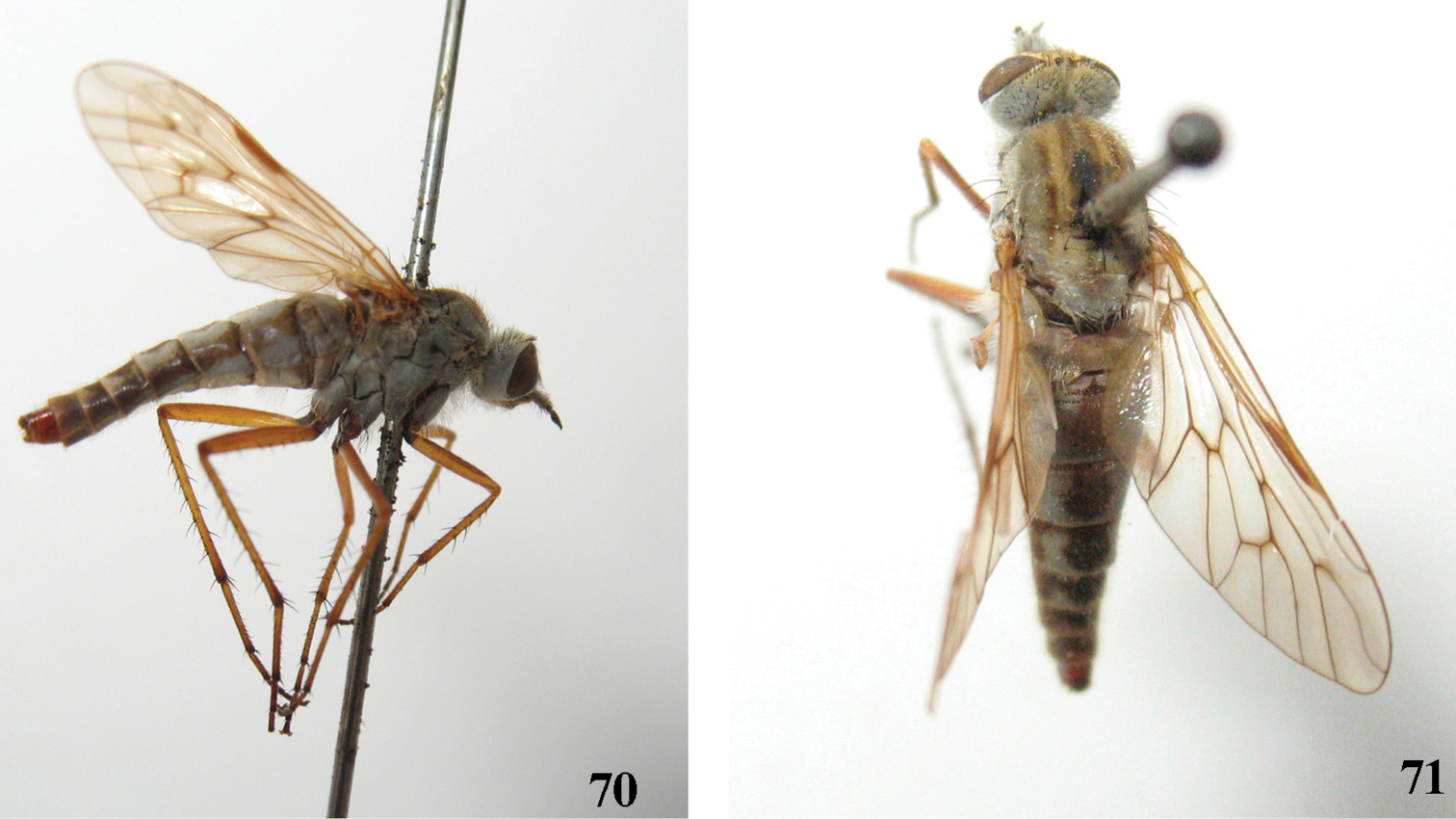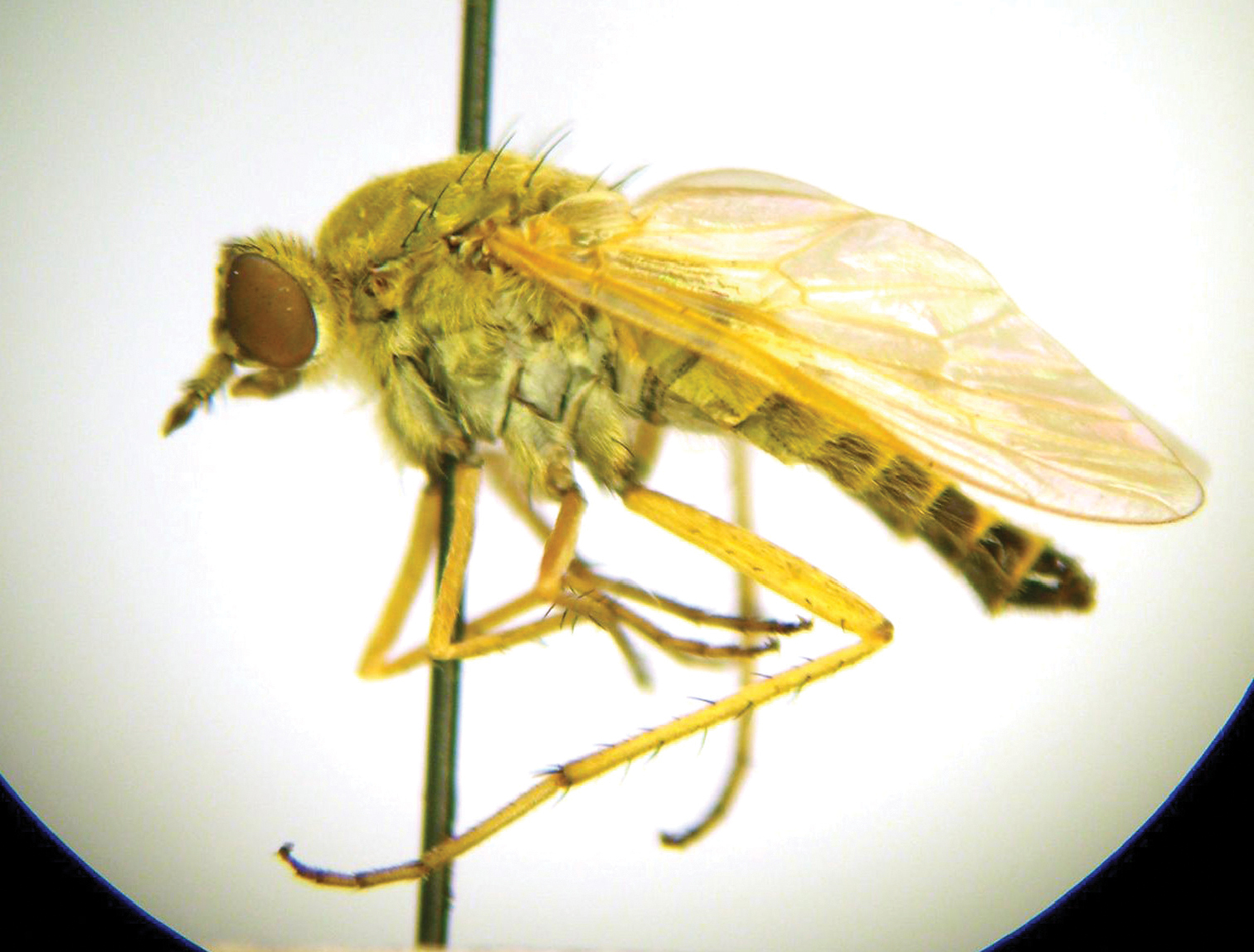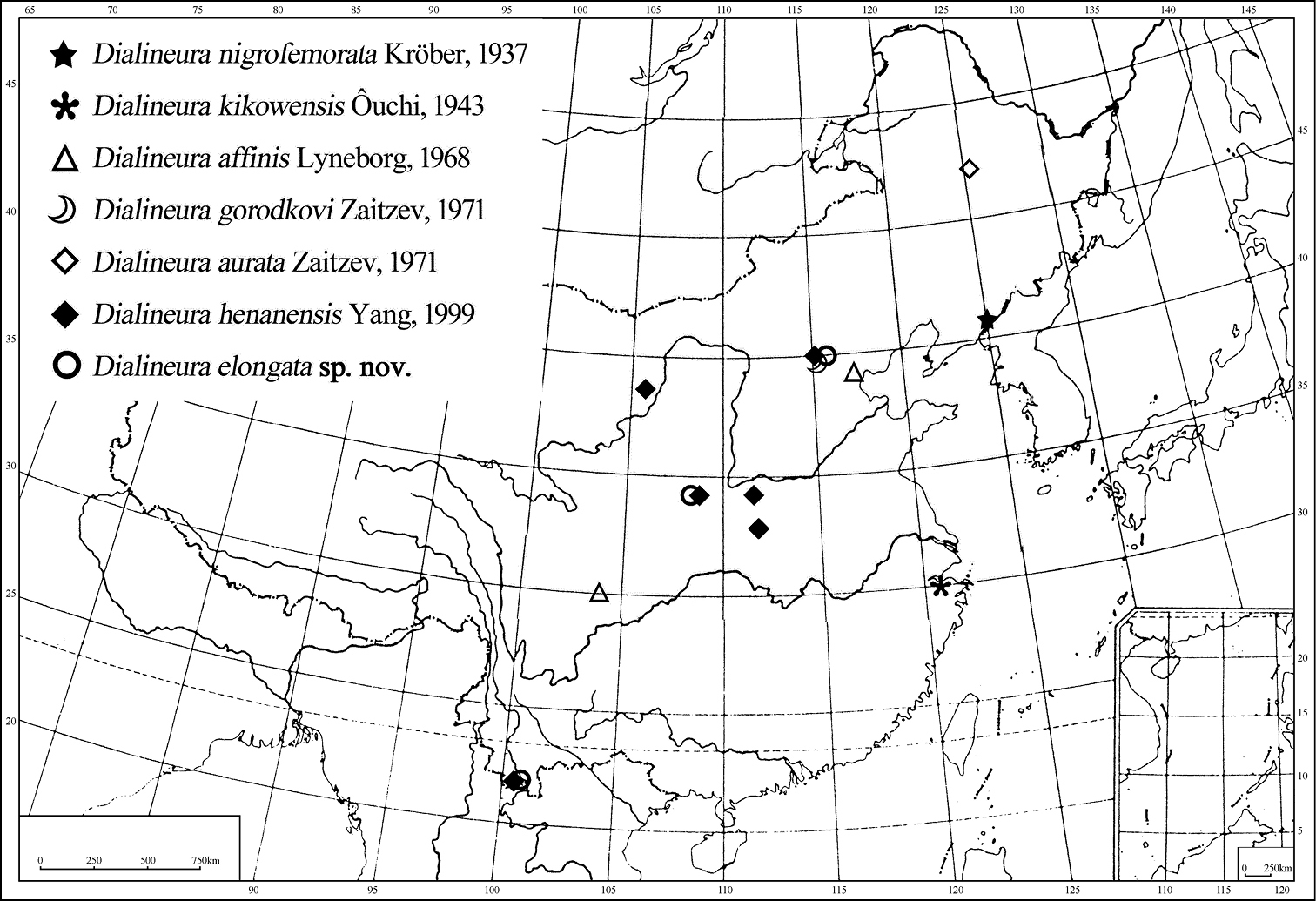






(C) 2012 Si-Pei Liu. This is an open access article distributed under the terms of the Creative Commons Attribution License 3.0 (CC-BY), which permits unrestricted use, distribution, and reproduction in any medium, provided the original author and source are credited.
For reference, use of the paginated PDF or printed version of this article is recommended.
The genus Dialineura Rondani is reviewed from China. One species, Dialineura elongata sp. n. is described as new to science. Two species, Dialineura nigrofemorata Kröber and Dialineura gorodkovi Zaitzev, are recorded from China for the first time. The female information of Dialineura henanensis Yang is also included here. A key to all the male species in the world and a biogeography map of China are presented.
Therevidae, Dialineura, new species, key to the world, distribution, China
The genus Dialineura Rondani, 1856 belongs to the subfamily Therevinae (Diptera: Therevidae). Until now, this genus had twelve known species in the world, which are distributed in Palaearctic region, Oriental region (i.e. China) and Nearctic region (i.e. Canada and USA). Four species have been known to occur in China: Dialineura kikowensis Ôuchi, 1943 from Zhejiang; Dialineura affinis Lyneborg, 1968 from Sichuan; Dialineura aurata Zaitzev, 1971 from Northeast China; Dialineura henanensis Yang, 1999 from Henan.
Both
The specimens were studied and illustrated with an OPTEC SMZ-B2 stereomicroscope. Male genitalic preparations were made by removing and heating the apical portion of the abdomen in lactic acid at 180°C temperature for 15 min, and rinsing in water and 75% ethanol. Female genitalic preparations were made by removing and rinsing the abdomen in a saturated NaOH solution at room temperature for one day, staining with a saturated Chlorazol Black solution in 75% ethanol, and rinsing in 75% ethanol. After examination, preparations were transferred to fresh glycerin and stored in a microvial pinned below the specimen. The habitus photographs of adults were taken with a digital camera (Canon EOS 450D). Type specimens were deposited in the Entomology Museum of China Agricultural University (CAU), Beijing.
Morphological terminology follows
The following abbreviations are used:
TaxonomyFollowing is a key to the world male species of the genus Dialineura. The males of Dialinuera kikowensis Ôuchi, 1943 and Dialineura aurata Zaitzev, 1971 are unknown, but we can identify females of these two species according to their distinct characters. The female Dialineura kikowensis has two wide yellow vittae on mesonotum (Fig. 71), apical margin of cell m3 narrower than cross-vein m-cu (see fig. 1,
Some figures cited in the key for the previously described species are from
| 1 | Substylus on gonocoxite absent | 2 |
| – | Substylus on gonocoxite present (Figs 52, 66) | 6 |
| 2 | Frons entirely with white pile | Dialineura albata (Coquillett, 1898) |
| – | Frons with some black setae | 3 |
| 3 | Distiphallus basally stout and ventrally curved (see Figs 2, 3, |
4 |
| – | Distiphallus basally slender and recurved (Figs 14, 34 | 5 |
| 4 | Dorsal apodeme of aedeagus distinctly raised in lateral view, distiphallus wide in dorsal view (see fig. 2, |
Dialienura anilis (Linné, 1761) |
| – | Dorsal apodeme of aedeagus relatively smooth in lateral view, distiphallus tapering in dorsal view (see fig.3, |
Dialienura mongolica Zaitzev, 1971 |
| 5 | Femora black with yellow tips (Fig. 26), pterostigma of wing pale yellow (Fig. 25); apical epandrium narrow with a triangular medial invagination (Fig. 30), dorsal apodeme of aedeagus 1/2 as long as ventral apodeme (Fig. 34) | Dialineura henanensis Yang, 1999 |
| – | Mid and hind femora mostly yellow (Figs 5, 6), pterostigma of wing brown (Fig. 3); apical epandrium wide with a trapezoidal medial invagination (Fig. 10), dorsal apodeme of aedeagus nearly as long as ventral apodeme (Fig. 14) | Dialineura elongata sp. n. |
| 6 | Distiphallus serrated at lateral edges (Fig. 67, 68 and see fig. 19, |
Dialineura affinis Lyneborg, 1968 |
| – | Distiphallus relatively smooth at lateral edges | 7 |
| 7 | Scape of antenna very large, at least 1.5 times longer than first flagellomere (see fig. 7, |
8 |
| – | Scape of antenna at most 1.3 times longer than first flagellomere | 9 |
| 8 | Tergites 2–4 with a black basal spot; subepandrial sclerite triangular (see fig. 5, |
Dialineura lehri Zaitzev, 1977 |
| – | Tergites 2–6 with a black basal band which produced medially; subepandrial sclerite trapezoidal (see fig. 28, |
Dialineura shozii Nagatomi & Lyneborg, 1988 |
| 9 | Subepandiral sclerite triangular, at most 2 times longer than cercus (see fig. 5, |
Dialineura gorodkovi Zaitzev, 1971 |
| – | Subepandrial sclerite constricted medially, at least 3 times longer than cercus (Fig. 51 and see figs 7, 8 and 10, |
10 |
| 10 | Only white pile present on fore femur (Fig. 45); epandrium 2 times longer than subepandrial sclerite (Fig. 51 and see fig. 6, |
Dialineura nigrofemorata Kröber, 1937 |
| – | Black pile distinctly present on fore femur; epandrium 1.5 times longer than subepandrial sclerite (see fig. 9, |
Dialineura lyneborgi Zaitzev, 1971 |
urn:lsid:zoobank.org:act:76D30027-1357-4ED4-96A7-148FDC879EB1
http://species-id.net/wiki/Dialineura_elongata
Figs 1-22, 73Male mesonotum with 3 wide brown vittae, separated by 2 narrow pale yellow stripes, the central vitta with a narrow grey stripe in the middle; female mesonotum with 3 wide brown vittae, separated by 2 narrow pale brown stripes, the central vitta with a narrow pale brown to dark brown stripe in the middle. Mid and hind femora mostly yellow. Pterostigma of wing brown. Male apical epandrium relatively wide with a trapezoid medial invagination; gonocoxite relatively wide apically; dorsal apodeme of aedeagus nearly as long as ventral apodeme; distiphallus recurved and S-shaped.
Male. Body length 7.1–8.5 mm, wing length 6.0–7.0 mm.
Head (Fig. 1) with dense pale pubescence over black ground color, central area of frons brown. White pile from gena to occiput, black setae on ocellar tubercle and frons, parafacial bare, upper occiput also with some black postocular setae. Eyes reddish brown and nearly contiguous on upper frons. Antenna with dense pale pubescence over black ground color, except first flagellomere and style brown; black setae on scape long and thick, but those on pedicel short and thin; first flagellomere nearly bare; central part of first flagellomere widest; style resting apically on first flagellomere with a tiny distal spine; antennal ratio: 5.0 : 1.0 : 4.1 : 0.7. Proboscis pale yellow with some black parts marginally, covered with short brown pile; palpus pale yellow with white pile.
Thorax with dense pale pubescence over black ground color; mesonotum (Fig. 2) with 3 wide brown vittae, separated by 2 narrow pale yellow stripes, the central vitta with a narrow grey stripe in the middle. Notum with sparse short white pile mixed with short black pile marginally, prosternum and pleuron with white pile; macrosetae on thorax black. Scutal chaetotaxy (pairs): np 3, sa 2, pa 1, dc 2, sc 2. Coxae and trochanters pale pollinose over black ground color, fore femur with pale pubescence over black ground color except apex yellow, both mid and hind femora (Figs 5, 6) yellow, except ventral surface of mid femur and apical dorsal part of hind femur dark brown, tibiae brownish yellow with dark brown apices, all tarsomeres 1–2 brownish yellow with dark brown apices, basal part of hind tarsomere 3 brownish yellow but apical part dark brown, other tarsomeres dark brown. White pile present on coxae and femora, setae on legs black. Fore coxa with a 1–2, av 1; mid coxa with a 3; hind coxa with a 2–3, d 1. Fore and mid femora without any prominent setae; hind femur with av 6, pv 3. Fore tibia with ad 2–4, pd 2–5, pv 4, apically with 7 setae; mid tibia with ad 3–4, pd 3, av 2–3, pv 2–5, apically with 6 setae; hind tibia with ad 5–8, pd 5–8, av 5–8, pv 4–7, apically with 6 setae. Wing (Fig. 3) hyaline tinged yellow; pterostigma very narrow, brown, at end of R1; veins brown. Halter stalk pale yellow but dark brown basally and apically; knob brown.
Abdomen with dense pale pubescence over black ground color, posterior margin of each segment pale yellow. White pile on abdomen, some black setae on terminalia. Male genitalia: Epandrium (Fig. 10) elongated, 1.4 times longer than wide, apically with a trapezoidal medial invagination. Subepandrial sclerite rectangular, as long as cercus. Gonocoxite (Fig. 11) relatively wide apically. Dorsal apodeme of aedeagus (Figs 12–14) nearly as long as ventral apodeme; distiphallus recurved and S-shaped.
Female. Body length 8.9–10.5 mm, wing length 6.5–7.9 mm.
Most characters of female are similar to the male, with following exceptions: Frons (Fig. 15) with dense dark brown pubescence over black ground color. Frons wide with 2 rows black setae, the narrowest point of frons 5 times wider than anterior ocellus. Antenna ratio: 4.2 : 1.0 : 3.9 : 0.7. Proboscis black but pale yellow marginally. Mesonotum (Fig. 16) with 3 wide brown vittae, separated by 2 narrow pale brown stripes, the central vitta with a narrow pale brown to dark brown stripe in the middle. Fore coxa with a 1, av 1; mid coxa with a 3; hind coxa with a 3, d 1. Fore and mid femora without any prominent setae; hind femur with av 6, pv 2. Fore tibia with ad 4, pd 4, pv 4, apically with 5 setae; mid tibia with ad 3–4, av 5, pd 4–5, pv 5, apically with 5 setae; hind tibia with ad 8, pd 9–10, av 8, pv 9, apically with 3 setae. Pale pubescence on abdomen thinner than the male. Female genitalia: Tergite 8 (Fig. 19) slightly longer than wide in dorsal view; sternite 8 (Fig. 20) rectangular in ventral view with an incision apically. Cercus (Fig. 22) semicircular. Subepandrial sclerite (Fig. 20) bell-shaped. Furca (Fig. 21) 1.7 times longer than wide. Accessory glands with separated ducts. Spermathecal sac rather large and spherical; two spermathecae.
Holotype male, CHINA: Shaanxi, Zhouzhi, Houzhenzi (33°53’N, 108°02’E), 1. V. 2009, Mao-Ling Sheng. Paratypes: 3 male, same data as holotype; 1 male, 2 female, CHINA: Yunnan, Xishuangbanna, Jinghong (21°58’N, 100°48’E, 300m), 27. IV. 2002, Wen-Quan Zhen; 1 male, CHINA: Shaanxi, Zhouzhi, Houzhenzi (33°53’N, 108°02’E), 8. V. 2009, Mao-Ling Sheng; 1 male, 1 female, CHINA: Beijing, Botanical Garden (39°59’N, 116°12’E), 24. IV. 2006, Hui Dong.
Palaearctic region: China (Shaanxi, Beijiia: Tergite 8 (Fig. 19) slightly longer than wide in dorsal view; sternite 8 (Fig. 20) rectangular in ventral view with an incision apically. Cercus (Fig. 22) semicircular. Subepandrial sclerite (Fig. 20) bell-shaped. Furca (Fig. 21) 1.7 times longer than wide. Accessory glands with separated ducts. Spermathecal sac rather large and spherical; two spermathecae.
Holotype male, CHINA: Shaanxi, Zhouzhi, Houzhenzi (33°53’N, 108°02’E), 1. V. 2009, Mao-Ling Sheng. Paratypes: 3 male, same data as holotype; 1 male, 2 female, CHINA: Yunnan, Xishuangbanna, Jinghong (21°58’N, 100°48’E, 300m), 27. IV. 2002, Wen-Quan Zhen; 1 male, CHINA: Shaanxi, Zhouzhi, Houzhenzi (33°53’N, 108°02’E), 8. V. 2009, Mao-Ling Sheng; 1 male, 1 female, CHINA: Beijing, Botanical Garden (39°59’N, 116°12’E), 24. IV. 2006, Hui Dong.
Palaearctic region: China (Shaanxi, Beijing); Oriental region: China (Yunnan) (Fig. 73). This is biogeographically part of North China Region and South China Region (
This new species is similar to Dialineura henanensis Yang from China, especially in the recurved and S-shaped distiphallus and the relatively wide apical gonocoxite. But it can be separated from the following features: most areas of the mid and hind femora of both male and female are yellow; the pterostigma of the wing is brown; the halter knob is brown; the epandrium is wide apically with a trapezoidal medial invagination; the subepandrial sclerite is rectangular, as long as the cercus; the dorsal apodeme of aedeagus is nearly as long as the ventral apodeme. In Dialineura henanensis, most areas of the mid and hind femora are black; the pterostigma of the wing is pale yellow; the halter knob is pale yellow; the epandrium is narrow apically with a triangular medial invagination; the subepandrial sclerite is triangular, nearly 2 times longer than the cercus; the dorsal apodeme of aedeagus is 1/2 as long as the ventral apodeme.
The specific name refers to the elongated distiphallus, from the Latin adjective “elongatus” meaning prolonged.
Dialineura elongata sp. n. Male. 1 head, frontal view 2 mesonotum 3 wing 4 habitus of male, lateral view 5 mid leg 6 hind leg.
Dialineura elongata sp. n. Male. 7 terminalia, lateral view 8 tergite 8 9 sternite 8 10 epandrium, cercus and subepandrial sclerite, dorsal view 11 gonocoxite and gonostylus, dorsal view 12 aedeagus, dorsal view 13 aedeagus, ventral view 14 aedeagus, lateral view. Scale: 0.2 mm.
Dialineura elongata sp. n. Female. 15 head, frontal view 16 mesonotum 17 wing 18 habitus of female, lateral view.
Dialineura elongata sp. n. Female. 19 terminalia, dorsal view 20 terminalia, ventral view 21 internal reproductive organs 22 terminalia, lateral view. Scale: 0.2 mm.
http://species-id.net/wiki/Dialineura_henanensis
Figs 23–42, 73Male mesonotum with 3 wide grey vittae, separated by 2 narrow pale yellow stripes, the central vitta with a narrow brown stripe in the middle; female mesonotum with 3 wide black vittae, separated by 2 narrow grey stripes, the central vitta with a narrow grey stripe in the middle. Pterostigma of wing pale yellow. Halter knob pale yellow. Male epandrium wide basally then suddenly narrow after middle line and with a triangular medial invagination apically; gonocoxite relatively wide apically; dorsal apodeme of aedeagus 1/2 as long as ventral apodeme; distiphallus recurved and S-shaped.
Male. Body length 7.3–8.5 mm, wing length 6.6–7.1 mm.
Other characters as described for Dialineura elongata sp. n., with following exceptions: Antennal ratio: 5.5 : 1.0 : 4.5 : 0.5. Proboscis black with short white pile; palpus black with white pile. Mesonotum (Fig. 24) with 3 wide grey vittae, separated by 2 narrow pale yellow stripes, the central vitta with a narrow brown stripe in the middle. Notum with sparse short white pile mixed with black pile. All femora (Fig. 26) black with yellow tips. Fore coxa with a 1, av 1; mid coxa with a 3; hind coxa with a 2–3, d 1. Fore and mid femora without any prominent setae; hind femur with av 6, pv 2–3. Fore tibia with ad 3–4, pd 3, pv 3, apically with 4 setae; mid tibia with ad 3, pd 3, av 3, pv 4, apically with 6 setae; hind tibia with ad 9, pd 6–8, av 8, pv 4–5, apically with 8 setae. Pterostigma of wing (Fig. 25) pale yellow; veins yellow. Halter stalk brownish yellow basally and dark brown apically; knob pale yellow. Anterior margins of tergites 2–3 of abdomen with very thin pubescence so that ground color is visible. Terminalia with only white pile. Male genitalia: Epandrium (Fig. 30) much elongated, 1.3 times longer than wide, apically narrowed with a triangular medial invagination. Subepandrial sclerite triangular, nearly 2 times longer than cercus. Dorsal apodeme of aedeagus (Figs 32–34) 1/2 as long as ventral apodeme.
Female. Body length 9.3–10.1 mm, wing length 7.0–7.9 mm.
Most characters of female are similar to the male, with following exceptions: Frons and antenna with dense brownish yellow pubescence over black ground color. Frons (Fig. 35) wide with 2 rows black setae, the narrowest point of frons 3–5 times wider than anterior ocellus. Antennal setae shorter than male; antennal ratio: 4.5 : 1.0 : 4.1 : 0.6. Proboscis with short brown pile. Mesonotum (Fig. 36) with 3 wide black vittae, separated by 2 narrow grey stripes, the central vitta with a narrow grey stripe in the middle. Notum with more pile than male. Fore coxa with a 1, av 1; mid coxa with a 3; hind coxa with a 3, d 1. Fore and mid femora without any prominent setae; hind femur with av 5–7, pv 4–5. Fore tibia with ad 3, pd 3, pv 2–4, apically with 6 setae; mid tibia with ad 3, pd 3, av 2, pv 4, apically with 6–8 setae; hind tibia with ad 7–9, pd 10, av 8, pv 5–7, apically with 6 setae. Most anterior margins of tergites of abdomen with very thin pubescence so that ground color is visible. White short setae mixed with brown short setae on abdomen, except tergite 1 with some white pile. Female genitalia: Tergite 8 (Fig. 39) quadrate in dorsal view; sternite 8 (Fig. 40) long trapezoidal in ventral view with an incision apically. Cercus (Fig. 42) semicircular. Subepandrial sclerite (Fig. 40) bell-shaped. Furca (Fig. 41) 2.2 times longer than wide. Accessory glands with separated ducts. Spermathecal sac rather large and spherical; two spermathecae, spherical.
1 male, CHINA: Beijing, Shangfang Mountain (39°39’N, 115°49’E), 22. V. 1976, Chi-Kun Yang; 4 male, 14 female, CHINA: Yunnan, Xishuangbanna, Jinghong (21°58'N, 100°48'E, 300m), 27. IV. 2002, Wen-Quan Zhen; 2 male, CHINA: Henan, Neixiang, Baotianman (33°31'N, 111°52'E), 20. V. 2006, Wei-Hai Li; 3 male, 3 female, CHINA: Beijing, Mentougou (39°56'N, 116°06'E), 30. V. 2008, Tao Wang; 1 male, CHINA: Shaanxi, Zhouzhi, Houzhenzi (33°53'N, 108°02'E), 5. V. 2009, Mao-Ling Sheng; 1 male, 1 female, CHINA: Yanqing, Song Mountain (40°29'N, 115°49'E; 780 m), 23. V. 2009, Wei-Na Cui & Jin-Jing Wang; 10 male, 22 female, CHINA: Beijing, Xiaolongmen Woodland (39°57'N, 115°26'E), 24. V. 2009, Li Shi, Hui Yu & Liang Liang; 52 male, 76 female, CHINA: Beijing, Xiaolongmen Woodland (39°57'N, 115°26'E; 1 177–1 430 m), 25. V. 2009, Li Shi, Hui Yu & Liang Liang; 16 male, 17 female, CHINA: Beijing, Ling Mountain, Ancient Road (39°59'N, 115°29'E; 1 022–1 144 m); Li Shi & Liang Liang; 1 female, CHINA: Beijing, Xiaolongmen (39°57'N, 115°26'E), 21. V. 2010, Tao Li; 1 male, CHINA: Inner Mongolia, Helan Mountain, Gulaben, Luanchaigou (39°00'N, 105°50'E), 10. VIII. 2010, Li-Hua Wang.
Palaearctic region: China (Henan, Beijing, Shaanxi, Inner Mongolia); Oriental region: China (Henan, Yunnan) (Fig. 73). This is biogeographically part of North China Region, Mongolia-Xinjiang Region and South China Region (
Dialineura henanensis Yang. Male. 23 head, frontal view 24 mesonotum 25 wing 26 habitus of male, lateral view.
Dialineura henanensis Yang. Male. 27 terminalia, lateral view 28 tergite 8 29 sternite 8 30 epandrium, cercus and subepandrial sclerite, dorsal view 31 gonocoxite and gonostylus, dorsal view 32 aedeagus, dorsal view 33 aedeagus, ventral view 34 aedeagus, lateral view. Scale: 0.2 mm.
Dialineura henanensis Yang. Female. 35 head, frontal view 36 mesonotum 37 wing 38 habitus of female, lateral view.
Dialineura henanensis Yang. Female. 39 terminalia, dorsal view 40 terminalia, ventral view 41 internal reproductive organs 42 terminalia, lateral view. Scale: 0.2 mm.
http://species-id.net/wiki/Dialineura_nigrofemorata
Figs 43–55, 73Male mesonotum with 3 wide black vittae separated by 2 narrow pale grey stripes. Pterostigma of wing yellow. Fore femur only with white pile. Male subepandrial sclerite very long; gonocoxite narrow apically and with substylus in interior margin.
Male. Body length 8.2 mm, wing length 7.0 mm.
Head (Fig. 43) with dense pale pubescence over black ground color, central upper area of frons brown. White to pale yellow pile from gena to occiput, black setae on ocellar tubercle and frons, setae on frons divided into 2 tufts, parafacial bare, upper occiput also with some black postocular setae. Eyes reddish brown and nearly contiguous on upper frons. Antenna with dense pale pubescence over black ground color, except first flagellomere and style brown; black setae on scape long and thick, but those on pedicel short and thin, first flagellomere nearly bare; central part of first flagellomere widest; style resting apically on first flagellomere with a tiny distal spine; antennal ratio: 3.6 : 1.0 : 3.5 : 0.9. Proboscis black with short brown pile; palpus brown with white pile.
Thorax with dense pubescence over black ground color; mesonotum (Fig. 44) with 3 wide black vittae separated by 2 narrow pale grey stripes. Notum with sparse white pile, prosternum and pleuron with white to pale yellow pile; macrosetae on thorax black. Scutal chaetotaxy (pairs): np 3, sa 2, pa 1, dc 1, sc 2. Coxae and trochanters pale pollinose over black ground color, femora with pale pubescence over black ground color except apices brownish yellow, tibiae brownish yellow with dark brown apices, all tarsomeres 1 brownish yellow with dark brown apices, other tarsomeres dark brown. White pile present on coxae and femora, setae on legs black. Fore coxa with a 1, av 1; mid coxa with a 3; hind coxa with a 3, d 1. Fore and mid femora without any prominent setae; hind femur with av 7, pv 8. Fore tibia with ad 4, pd 5–6, pv 4–6, apically with 6 setae; mid tibia with ad 5, pd 5, av 4, pv 4, apically with 7 setae; hind tibia with ad 9, pd 10–11, av 9–10, pv 7, apically with 6 setae. Wing (Fig. 46) hyaline tinged yellow; pterostigma very narrow, yellow, at end of R1; veins brown except basal surface of wing pale yellow. Halter stalk brownish yellow basally and black apically; knob brown.
Abdomen with dense pubescence over ground color, except tergite 1 and anterior margins of tergites 2–3 with very thin pubescence so that ground color is visible, posterior margin of each segment pale yellow. White pile on abdomen and terminalia. Male genitalia: Epandrium (Fig. 51) elongated, 1.3 times longer than wide, apically narrowed with a triangular medial invagination. Subepandrial sclerite slightly constricted in the central area, nearly 3 times longer than cercus. Gonocoxite (Fig. 52) narrow apically and with substylus in interior margin. Distiphallus (Figs 53–55) short and curved, basal part of distiphallus relatively stout.
Female. Unknown.
1 male, CHINA: Liaoning, Xinbin (41°43’N, 125°02’E), 7. VII. 2005, Juan Li.
Palaearctic region: China (Liaoning) (Fig. 73), Russia. In China, this is biogeographically part of Northeast Region (
Dialineura nigrofemorata Kröber. Male. 43 head, frontal view 44 mesonotum 45 fore femur 46 wing 47 habitus of male, lateral view.
Dialineura nigrofemorata Kröber. Male. 48 terminalia, lateral view 49 tergite 8 50 sternite 8 51 epandrium, cercus and subepandrial sclerite, dorsal view 52 gonocoxite and gonostylus, dorsal view 53 aedeagus, dorsal view 54 aedeagus, ventral view 55 aedeagus, lateral view. Scale: 0.2 mm.
http://species-id.net/wiki/Dialineura_gorodkovi
Figs 56, 57, 73Black setae on frons (Fig. 56) very long and dense, even expand to parafacicals. Male mesonotum (Fig. 57) with 3 wide dark brown vittae, separated by 2 narrow brownish grey stripes, the central vitta with a narrow brownish grey stripe in the middle. Pterostigma of wing dark brown. Male subepandrial sclertie (
2 male, CHINA: Beijing, Xiaolongmen (39°57’N, 115°26’E), 21. V. 2010, Tao Li.
Palaearctic region: China (Beijing) (Fig. 73), Russia; Nearctic region: Canada and USA. In China, this is biogeographically part of North China Region (
Dialineura gorodkovi Zaitzev. Male. 56 head, frontal view 57 mesonotum.
http://species-id.net/wiki/Dialineura_affinis
Figs 58–69, 73Frons with white pile. Pterostigma of wing brownish yellow. Male gonocoxite narrow apically and with substylus in interior margin; distiphallus serrated at lateral edges.
Male. Body length 8.1–8.5 mm, wing length 6.0–7.2 mm.
Head (Fig. 59) with dense pale pubescence over black ground color. White pile on frons and from gena to occiput, brown pile on ocellar tubercle, parafacial bare, upper occiput also with some black postocular setae. Eyes reddish brown and nearly contiguous on upper frons. Antenna with dense pale pubescence over black ground color; black setae on scape long and thick, but those on pedicel short and thin, scape also covered with long white pile, first flagellomere nearly bare; central part of first flagellomere widest; style resting apically on first flagellomere with a tiny distal spine; antennal ratio: 5.3 : 1.0 : 4.3 : 0.8. Proboscis brownish yellow with short brown pile; palpus pale brownish yellow with white pile.
Thorax with dense pale pubescence over black ground color (as the pubescence on the mesonotum of specimens are totally scraped off, the pattern on the mesonotum is unknown). Notum with dense white pile, prosternum and pleuron with dense white pile; macrosetae on thorax black. Scutal chaetotaxy (pairs): np 3, sa 2, pa 1–2, dc 2, sc 2. Coxae and trochanters pale pollinose over black ground color, femora with pale pubescence over black ground color except apices brownish yellow, tibiae brownish yellow with dark brown apices, all tarsomeres 1 brownish yellow with dark brown apices, other tarsomeres dark brown. White pile present on coxae and femora, setae on legs black. Fore coxa with a 1, av 1; mid coxa with a 3; hind coxa with a 2, d 1. Fore and mid femora without any prominent setae; hind femur with av 6, pv 3. Fore tibia with ad 3–4, pd 3, pv 4, apically with 4–5 setae; mid tibia with ad 3–4, pd 4, av 5, pv 4, apically with 6 setae; hind tibia with ad 7–9, pd 8, av 7–8, pv 6–7, apically with 5 setae. Wing (Fig. 60) hyaline tinged yellow; pterostigma very narrow, brownish yellow, at end of R1; veins brown except upper basal surface of wing yellow. Halter stalk yellow but dark brown apically; knob brown.
Abdomen with dense pale pubescence over black ground color, except tergite 1 and terminalia with very thin pubescence so that ground color is visible, posterior margin of each segment pale yellow. White pile on abdomen and terminalia. Male genitalia: Epandrium (Fig. 65) elongated, 1.5 times longer than wide, apically narrowed with a triangular medial invagination. Subepandrial sclerite trapezoid, little longer than cercus. Gonocoxite (Fig. 66) with substylus, relatively narrow apically. Distiphallus (Figs 67–69) short and curved, serrated at lateral edges.
Female. Unknown.
3 male, CHINA: Tianjin, Qingguang Farm (39°13'N, 117°00'E), 9. IV. 1965; 1 male, CHINA: Tianjin, Qingguang Farm (39°13'N, 117°00'E), 10. IV. 1965. The collectors are totally unknown.
Oriental region: China (Sichuan); Palaearctic region: China (Tianjin) (Fig. 73). This is biogeographically part of Southwest Region and North China Region (
Dialineura affinis Lyneborg. Male. 58 habitus of male, lateral view 59 head, frontal view 60 wing 61 parafacial.
Dialineura affinis Lyneborg. Male. 62 terminalia, lateral view 63 tergite 8 64 sternite 8 65 epandrium, cercus and subepandrial sclerite, dorsal view 66 gonocoxite and gonostylus, dorsal view 67 aedeagus, dorsal view 68 aedeagus, ventral view 69 aedeagus, lateral view. Scale: 0.2 mm.
http://species-id.net/wiki/Dialineura_kikowensis
Figs 70, 71, 73Female mesonotum with two wide yellow vittae. Apical margin of cell m3 narrower than cross-vein m-cu (
Holotype female, CHINA: Zhejiang, Xikou (29°41’N, 121°16’E), 11. V. 1936. The collector is unknown.
Oriental region: China (Zhejiang) (Fig. 73). This is biogeographically part of Central China Region (
Dialineura kikowensis Ôuchi. Female. 70 habitus of female, lateral view 71 habitus of female, dorsal view.
http://species-id.net/wiki/Dialineura_aurata
Figs 72, 73Head and entire body covered with dense bright yellow pubescence. Legs pale yellow. Segment 8 of abdomen shinny black. (
Palaearctic region: China (Northeast region) (Fig. 73) (
Habitus of female Dialineura aurata Zaitzev, 1971, lateral view.
Distribution of Dialineura in China.
We are grateful to Prof. Chi-Kun Yang (Beijing), Prof. Mao-Ling Sheng (Liaoning), Dr. Hui Dong (Guangdong), Dr. Li Shi (Sacramento), Dr. Wei-Hai Li (Henan), Dr. Jin-Jing Wang (Tianjin), Ms. Wei-Na Cui (Shandong), Ms. Hui Yu (Shanghai), Ms. Tao Li (Henan), Ms. Li-Hua Wang (Beijing), Ms. Juan Li, Mr. Liang Liang (Beijing), Mr. Wen-Quan Zhen and Mr. Tao Wang for collecting the specimens. We appreciate Mr. Xian-Wei Liu (Shanghai), Dr. Thomas Pape (Copenhagen), Dr. Martin Hauser (Sacramento), Dr. Frederic Thompson (Washington D.C.), Dr. Shaun Winterton (Sacramento), Dr. Toyohira Saegusa (Fukuoka) and Dr. Vera Richter (St. Petersburg) for providing the photos of the type specimens. Dr. Stephen D. Gaimari (Sacramento), Dr. Shaun L. Winterton (Sacramento), Dr. Donald Webb, Dr. Shelah I. Morita (Washington D.C.) and an anonymous reviewer are thanked for providing useful comments on an earlier draft of this paper. This research is funded by Special Fund for Agro-scientific Research in the Public Interest (No. 201003079).
